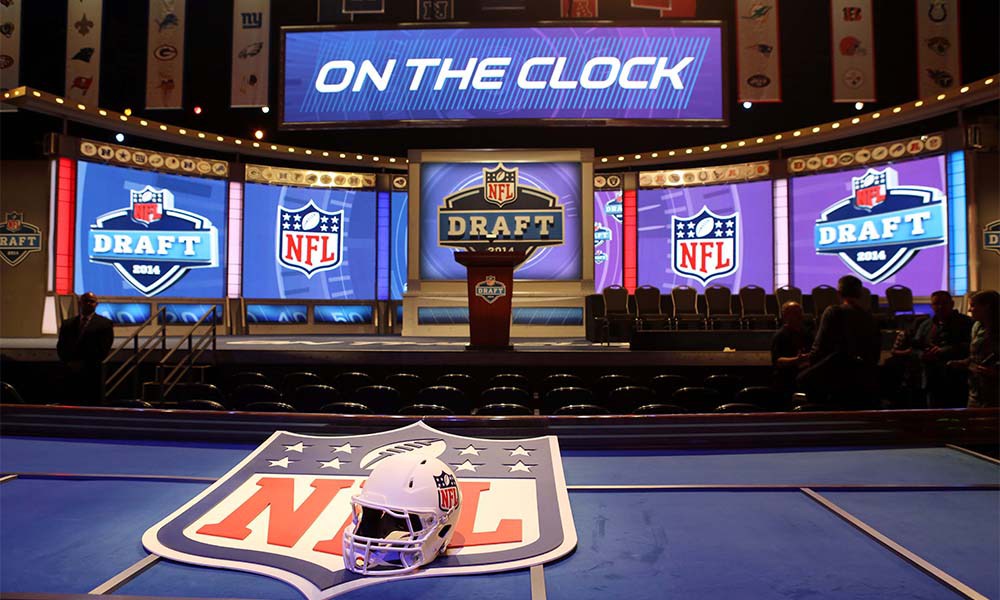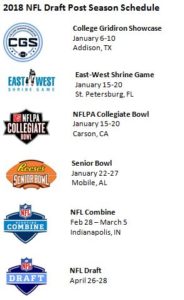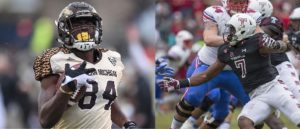Tag: 2018 NFL Draft
Declaring early for NFL Draft – Is it worth the risk?
 By Justin VanFulpen
By Justin VanFulpen
This time of the year in college football, the mock drafts start coming out and people start talking about what players will declare early. But just because some on the internet is saying that this player should declare early or someone close to the player telling him that he should leave school early might not know all the facts.
1. NFL Scouts weren’t allowed to scout underclassmen, until this season when the rule was changed. But with this rule change this year with the new agreement with the AFCA and NFL that took effect, where school gave the scout a list of 5 possible players that could declare that they were allowed to get info on. Scouts do look at the guys that they know for sure will be coming out early, but their main focus is the senior prospects. The underclassmen that aren’t general accepted as a 1st round pick there is rarely any work done on them during the season.
2. Underclassmen aren’t allowed at post season all-star games. 6 years ago with the NFLPA started the NFLPA Collegiate Bowl they were going to challenge the NFL rule and did allow one underclassmen in the game. That caused the NFL teams not to send a single scout to that all-star game. Because of that the NFLPA has only allowed seniors in their all-star game for then on. As we saw in the 2013 NFL Draft All-Star games are a big part of the process where OT Eric Fisher, Central Michigan went from a late first rounder all the way up to the number one overall pick because of his play at the Senior Bowl.
3. NFL Combine – First official time NFL scouts can talk to underclassmen. Just because a prospect has declared early doesn’t automatically get him an invite to the NFL combine. So if a prospect is not invited then really the first time a scout get to talk with a prospect is at his school Pro Day.
4. NFL Draft Advisory Board – The board is composed of general managers and personnel directors from a number of NFL teams, along with the directors of the NFL’s two scouting combines, BLESTO and National. A prospect can ask for their assessment on where he is projected to get drafted. The board will return their assessment of the prospect with three possible grades – first round, second round, or neither, which means that the board advises the player to stay in school. The school can get a hold of the NFL Draft Advisory Board or the prospect can contact the NFL Player Personnel Department directly.
5. The 2017 NFL Draft included 95 underclassmen and another eight who entered the draft having earned a degree but still with NCAA playing eligibility. 67 underclassmen were drafted, leaving 28 (30 percent) not drafted. The 2016 NFL Draft 30 of 96 underclassmen were not chosen (31 percent).
Every prospects situation is different when thinking about declaring early for the NFL Draft but each prospect should get as much information as possible in regards to leaving school early for the NFL Draft.
2018 NFL Draft Post Season Schedule
Only Film can raise your NFL Draft stock – Not your 40 time
By Justin VanFulpen
Now that the 2017 NFL Draft is in the books, many people are looking forward to the 2018 including the draft prospects for next year draft. But if there is one thing that stood out in the 2017 NFL Draft is film is king and for the most part nothing else really matters. People get excited for the NFL Combine to come and see how fast the NFL prospects run but one of the biggest shocks to many was the WR Corey Davis, Western Michigan went #5 overall to the Tennessee Titans. Davis got hurt training and never did any of the testing, never ran a 40 and still was the #5 overall draft pick and was the first WR selected in the 2017 NFL Draft. He sent in a video to all 32 teams of him running routes showing that he was almost back health from his ankle injury before the NFL Draft.
LB Haason Reddick, Temple came into the season with a spring grade from NFL scouts with a grade that he couldn’t play in the NFL (In the past it was called a reject grade), not even a low free-agent grade. Basically saying he isn’t even someone to watch as a draft prospect. But what did Reddick do this season he showed on film that the scout spring grade was wrong, he had a huge season, he was second on the team in tackles, first of the team in tackles for loss and sacks. With that great season got him an invite to the Senior Bowl which he had a great week in front of scouts many who at the being of the process back in the spring said he couldn’t play in the NFL. He was invited the NFL Combine and checked off the box on the numbers that a NFL linebacker should in the time and testing part. Reddick went on to be the #13 overall pick in the 2017 NFL Draft by the Arizona Cardinals.
But as many GMs will tell you their team’s board is set before the even get to the NFL Combine. As Detroit Lions GM Bob Quinn said after this year NFL draft after drafting Teez Tabor out of Florida who didn’t run well as the NFL Combine or his Pro Day. (Link here)
Both Corey Davis and Haason Reddick where first round picks who didn’t play in a Power 5 conference and both show that it is about the film, and that it not about your grade going into the season or what you run of even if you run a 40. Film is key and at the end of the day that is your resume to NFL teams.
2018 NFL Draft process starts with “Junior Days” and Spring Grades
 By Justin VanFulpen
By Justin VanFulpen
Right now we are getting close to the 2017 NFL Draft but NFL scouts around the country are getting ready to start their work on the 2018 NFL Draft on college campus in what is called “Junior Days”.
What are “Junior Days”? Well there are two scouting organizations that NFL teams subscribe to called BLESTO and National (National Football Scouting) each of these organizations is made up of scouts from different teams, and all except the New England Patriots “subscribe” to one of these services.
Normally the college coach who is the pro liaison sets up the junior day in which the draft-eligible players for the next year take part in a workout much like a Pro Day just for these scouts. These junior days are normally scheduled during spring practice.
Scouts do measurable, the player’s height, weight, hand size and reach, some school will allow their players to run the 40 but others won’t. The scouts will also have the players take the Wonderlic test which is a standardized test which is used to assess the aptitude of prospective employees for learning and problem-solving.
The scouts also view film for the player’s junior year as well as background information and injury history. From there, only a single report is filed and shared with the other teams as part of the group, and then there is a meeting where the reports are shared with the member clubs sometime in late May.
Once those reports are filled that is when people in the football business try to get their hands on those reports or just the grades. Even though all information from National Football Scouting and BLESTO are proprietary, agents, financial advisors, trainers, all-star game organizers, media members, and NFL draft gurus all try to get their hands on what is referred to as the “spring grades.”
Once anyone gets their hands on these grades they will start contacting the players letting them know what their “spring grade” is.
These grades are not set in stone and they sure change thru out the season but they are for sure a great starting point. The grade that either of these services gives a player the May before he plays senior season doesn’t have a huge effect on where the player is drafted a full year later but does have a good bearing if the player will get invited to the NFL Scouting Combine which is run by National and has input by BLESTO on who gets invited.
Springs grades are important starting point for people in football business and the prospects.



